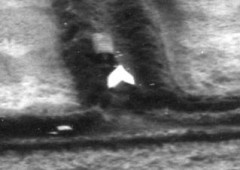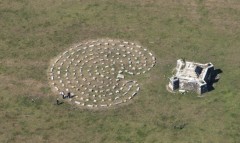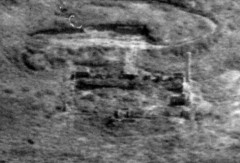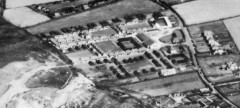The North Devon Coast has long been a draw for holiday makers and the varied landscape provides ample opportunity for recreational activities on sea and inland.
Accommodation for overnight visitors is widespread, and some unusual historical examples were spotted during the survey. These included a ruined structure near Putsborough, which was identified, following an AONB appeal on a social networking site, as the former Heathercombe Hotel (MDV103329). Locals agreed that it had been burnt down whilst requisitioned as a girls’ school for evacuees during the Second World War, with the consensus that one person was tragically killed in the blaze. The memorable suggestion was made that the fire was started by a pot of blackberry jam boiling over, although no respondents confirmed this for certain and a more prosaic explanation cannot be ruled out.
Former hotel near Putsborough with its distinctive chimney stack. RAF/P58/2555 PSFO-P1 0377 SS4541/3 01-SEP-1958. English Heritage (RAF Photography).
Several holiday camps have an interesting past that is perceptible on the aerial photographs, including Croyde (MDV57320), Seafield (MDV102172) and Hilltop Camps (MDV103322). Aerial photographs show temporary military buildings sitting somewhat incongruously next to holiday chalets at Croyde and Seafield, although at Hilltop relatively little military alteration is visible. During the war Westward Ho! and Ilfracombe accommodated several thousand Jewish refugees of German and Austrian nationality, and both Seafield and Hilltop holiday camps were requisitioned to accommodate many of these displaced persons who became members of the Pioneer Corps, a multipurpose labour corps in the British Army (Fry 2005). From 1943, Croyde Camp housed some of the troops undergoing training for D-Day, with the officers billeted in the chalets (Bass 2005). Many ‘tent cities’ (such as those on Braunton Burrows, e.g. MDV57317, MDV102707) and the extensive purpose built camp at Braunton (MDV52983) were also required to house the vast numbers of US troops passing through the Assault Training Centre.
Requisitioned holiday camp at Croyde, RAF/106G/UK/1684 PSFO-0001 SS4338/15 08-AUG-1946. English Heritage (RAF photography).
Some years after the war, this group of a caravan, car and tent was photographed during an RAF sortie. Initially we considered the possibility that this was evidence of itinerant workers brought in to help with harvesting. However an alternative explanation offered by a local resident is that this is an example of a different type of holiday home. If you remember caravans like this in North Devon we’d like to hear from you.

Facilities for those at leisure included the former open air pool at Appledore (MDV102538), thought to have been constructed in the 1930s. In common with many other open air pools throughout the country, this did not survive to see the end of the twentieth century. Longer lived is the golf course on Northam Burrows, still in use today. Aerial photographs from the 1940s depict sheep grazing the course, as they do now, although in 1944 it was surrounded by marks probably caused by barbed wire anti-invasion defences from the early part of the Second World War.

Another probable golf course visible as earthwork platforms on aerial photographs was not so lucky. This site, at Higher Warcombe (MDV103056) appears to have been abandoned before or during the Second World War. Do you know more about who created these platforms and when? If so, why not let us know!
The South West Coast Path is a popular long distance route, designated in 1978, and is clearly visible in many of the more recent aerial photographs. It provides access to and between a number of archaeological sites, most notably the prehistoric coastal forts. The route was used as a coastguard path in the nineteenth century, but it is interesting to speculate on whether parts of it could have their origins in prehistory (Alex Green pers. comm.).
Formal recreational landscapes with more limited access that are visible on the aerial photographs include the designed parklands of Clovelly and Tapeley Park. Although these were recorded in the HER prior to the aerial survey, some additional records have been made, for example for the earth
Modern Maze at Tapeley Park. NMR SS4729/019 NMR 27260/41 05-JUL-2010 © English Heritage.
Bass, R.T. 2005 Spirits of the Sand Field Edition: U.S. Army Assault Training Centre of WWII. Privately Published.
Fry, H. 2005 Jews in North Devon. Tiverton: Halsgrove.

